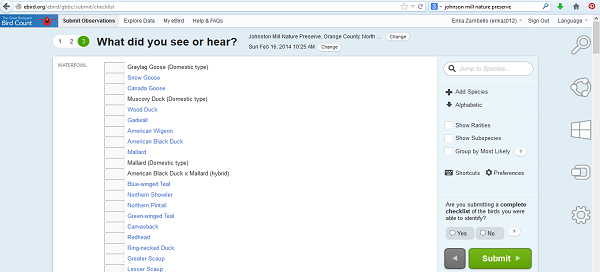International Migratory Bird Day is tomorrow, May 9th, and this year’s theme is “Restore Habitat,…
I arrived in mid-morning to the Johnston Mill Nature Preserve, my designated Great Backyard Bird Count site. The air was chilly but the sun was shining with the promise of warmer temperatures, and I could practically hear the snow melting from the forest floor and running into New Hope Creek. Even from the parking area I heard the twitter and cheeps of birds farther into the woods, and I readied my recording notebook, noted my start time, checked my camera, and headed along the path into the preserve.
The Cornell Lab of Ornithology, Audubon Society, and Bird Studies Canada teamed up to host their annual Great Backyard Bird Count (GBBC) from February 14 – February 17. Amateur and professional birders all over the world went out wherever they lived and counted birds, submitting their checklists to the website. In one of the best examples of citizen science, the data is compiled along with other citizen-science projects to map the changing distribution of bird species across the globe. Their simple rules made it easy to participate: over the four- day span, each birder had to count birds for only fifteen minutes for one day of the count. Anyone could submit more checklists or count birds for a longer period of time, but fifteen minutes was the minimum.
Though I was only counting one of the four days, I planned on exploring the nature preserve for at least an hour. As I moved away from the road, I found New Hope Creek swollen with the water from the recent snowmelt, fed by countless streams trickling across its banks. Though it was melting, the snow lit up the forest from below, sparkling in the sun that peeked through the trees. Two Tufted Titmice flew down to investigate me, as well as a Carolina Chickadee, making my first three birds of the count. At the base of a hill I heard three Carolina Wrens, bringing my total count up to six birds. Not bad for the first five minutes!
Birding in the winter has its advantages. While summer and fall may be beautiful, the trees are also full of leaves that can hide or obscure any birds in the canopy. Though there are fewer birds to see in the winter, the bare branches provide a full view for anyone who doesn’t mind craning their necks up to look. Doing just that I spotted a Downey Woodpecker shuffling up and down a trunk at least thirty feet up in the air, a view that would have been difficult had the surrounding branches been leafed out.
Continuing on Robin’s Trail, I bordered the creek while keeping my eyes open, when suddenly one of my favorite birds of all time landed on a trunk barely three feet from where I was standing! Golden-crowned kinglets, one of America’s smallest songbirds, are as active as any bird you’ll ever see. They hop, they flit, they hang upside down from branches or seeds before rapidly zooming off in another direction. Given their movement mania, snapping a decent photo of a kinglet is almost impossible, so I was thrilled when the kinglet barely an arm’s length away merely sat and looked at me for thirty seconds before disappearing up into the canopy. Its bright yellow crest – from which it derives its name – almost seemed to glow in the sunlight.
I saw many kinglets on my walk, so many I was worried I was counting them twice. As I ascended the wooden steps I spotted a Red-bellied Woodpecker exploring a large hardwood tree, as well as more chickadees and titmice.
From Robin’s Trail I took a side trip on the Bluebird Trail, heading away from the creek and farther into the forest. Though I had so much left of the preserve to explore, I decided to retrace my steps from there in case I had missed anything the first time. Reaching New Hope Creek once more, I was startled by a great flapping of wings and a gentle descent of a large bird landing on a bare branch overlooking the water. My first hawk of the trip.
I find hawks very difficult to identify. Luckily for me, the Triangle woods sport raptors mostly of the Red-shouldered and Red-tailed variety, and this hawk, with its black and white striped tail, was definitely a Red-Shouldered. There is something magical about hawks. The woods were silent except for the gurgling of the stream below, and for five minutes I held my breath and watched the copper-colored creature. Every once in a while the hawk would turn, fixing me with its sharp eyes before looking away again, clearly unperturbed by my presence. I was only released from its spell when it stretched its great wings once more and flew off into the trees, disappearing from view.
I was thrilled with my Red-shouldered Hawk, but barely five minutes later came across not one, but two more raptor species. Robin’s Trail transects a powerline cut, which offers brushy, field-like habitat for birds and mammals. Perched atop one of the wooden poles was the silhouette of another hawk, though from the distance it was almost impossible to tell species type. Just as I resigned myself to the unknown, the hawk took off and soared right overhead, revealing the white belly and chest striping of a young Red-tailed Hawk. As I snapped a photo I saw a second circling directly above me! Just as I was giving myself a mental high five and jotting down my observation, a Turkey Vulture soared past, bringing up my raptor count to four.
The return walk brought me two more species. Sidling up and down a medium-sized pine trunk in front of the trail was a male Yellow-bellied Sapsucker, forehead and neck ablaze with red feathers. Completely uninterested in my presence, the male sapsucker continued its rapid ascent and descent of the tree looking for food. Finally, a Pine Warbler busily fed from seeds in a tall pine stand overlooking the parking lot, making my last bird-list entry.

Back in the car, I tallied my totals. I had seen 12 species, and more than 35 birds in all. Not bad for an hour and a half. Though I bird all the time, it was so satisfying to submit my checklist, knowing my count, however small, would be used to support a giant research endeavor that could eventually be used to help the birds I love so much. I know I will definitely be participating in the GBBC again next year!
See a complete slideshow on our Flickr page at: http://www.flickr.com/photos/trianglelandconservancy/sets/72157641118345615/
